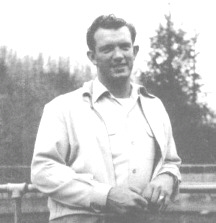Submitted by Earl Lanning
I can’t remember the date or place, but the Rochester had put a small force of men in a 50-foot motor launch. They had been assigned a mission. When the 3rd Div. lowered the launch into the water, conditions were calm. I can’t recall what these men were doing, perhaps chasing mines. We did a lot of that along the Korean coast. I do recall an old pal of mine was the coxswain running the launch. His name was Fred Hancock from South Carolina. The launch and crew were gone for some time.
While they were out on their mission, a storm blew up and the seas got terribly rough. As soon as we spotted the launch, the crane operator swung the crane over the port side to retrieve them. In case you guys don’t remember how this was done, I will refresh your memories. There were four heavy cables about twenty feet in length, attached to the gunnels of each launch. These cables were then attached to a rather heavy, round steel ring. On being lifted aboard, one of the crew stood on one of the seats, holding the ring and the cables as far up as he could, and tried to connect the hook, which was being lowered by the crane operator. In calm seas the crew did this very quickly due to the expertise of the crane man and the crewman.
But the conditions had changed, and were getting worse by the second. The ship was rolling and pitching violently and so was the motor launch. I watched as one crewman after another fell exhausted trying to hang the large ring over the crane hook. As the seas getting rougher, Coxswain Hancock was doing a terrific job keeping the launch in retrieving position. But the situation was getting desperate. It was to the point we could lose the launch and all aboard.
There were perhaps thirty men and officers watching this drama unfold. All of a sudden someone yelled at me to come and help him. It was the Captain Himself, CAPT Charles F. Chillingsworth. He told me to help him lay down the fueling lines that were hanging on racks at the base of turret #3. I had no idea what he was going to do. More hands fell in and helped us. Before long we had the lines all joined and hooked to the refueling system. The Captain grabbed the end of the fueling line and heaved it over the side right at the motor launch. He ordered that the pumps be started. There was a loud gurgling sound with blasts of air, and all of a sudden a great gush of oil spouted into the water around the launch. Like magic, the water smoothed out into a lake of tranquility. The launch sat almost motionless in the water. One of the crew dropped the ring over the crane hook and the operator hoisted the launch and crew aboard.
We were all awestruck. The Captain was still next to me and I stuck out my hand and said “Congratulations”. I thought only Moses could work miracles with water. He said, “It wasn’t a miracle, son, just old-time seamanship.” I will never forget him turning and walking away with oil dripping from his dress blue uniform. WOW! I thought I had just witnessed the REAL Navy and what type of man the Captain really was.
The launch crew seemed no worse off for the episode. They were soaked with oil and exhausted, but happy to get some hot coffee in them and be back aboard. I wish I could remember the date and location, etc., that this occurred. Perhaps some of the shipmates can fill in the blank spots.
Captain Charles F. Chillingsworth, USN, of Washington D.C., relieved Captain Smith as commanding officer of the ROCHESTER January 28, 1952, and directed the heavy cruiser’s operations during the remainder of the Far East tour.
He was born in Honolulu, Hawaii and was graduated from the Naval Academy in 1925. He served in both submarines and surface craft. During WWII he was awarded the Legion of Merit and three Bronze Stars with combat “V” while serving with Task Force II and Task Force 58 in the South Pacific.
Prior to assuming command of the ROCHESTER, Captain Chillingsworth headed the Plans Development Section of the Strategic Plans Division in the Office of the Chief of Naval Oprations.

